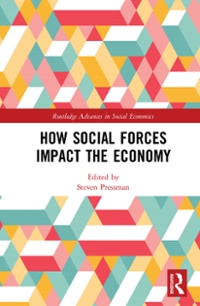Question
1.Suppose the adult population over the age of 16 is 237.8 million and the labor force is 153.9 million (of whom 139.1 million are employed).
1.Suppose the adult population over the age of 16 is 237.8 million and the labor force is 153.9 million (of whom 139.1 million are employed). How many people are "not in the labor force?" What are the proportions of employed, unemployed and not in the labor force in the population?Hint: Proportions are percentages.
2.Using the above data, what is the unemployment rate? These data are U.S. statistics from 2010. How does it compare to the February 2015 unemployment rate computed earlier?
3.Over the long term, has the U.S. unemployment rate generally trended up, trended down, or remained at basically the same level?
4.Whose unemployment rates are commonly higher in the U.S. economy:
- Whites or non-Whites?
- The young or the middle-aged?
- College graduates or high school graduates?
5.Beginning in the 1970s and continuing for three decades, women entered the U.S. labor force in a big way. If we assume that wages are sticky in a downward direction, but that around 1970 the demand for labor equaled the supply of labor at the current wage rate, what do you imagine happened to the wage rate, employment, and unemployment as a result of increased labor force participation?
6.Is the increase in labor force participation rates among women better thought of as causing an increase in cyclical unemployment or an increase in the natural rate of unemployment? Why?
7.Many college students graduate from college before they have found a job. When graduates begin to look for a job, they are counted as what category of unemployed?
1. Use the life-cycle model of consumption to discuss a change in the interest rate for a consumer who is a borrower in the first period. Discuss the income and substitution effects on consumption in both periods.
2. Jack an Jill both obey the two-period model of consumption. Jack earns $100 in the first period and $100 in the second period. Jill earns nothing in the first period and $210 in the second period. Both of them can borrow or lend at the interest rate. r?
a. You observe both Jack and Jill consuming $100 in the first period and $100 in the second period. What is the interest rate r?
b. Suppose the interest rate increases. What will happen to Jack's consumption in the first period? Is Jack better of or worse off than before the interest rate rise? c. What will happen to Jill's consumption in the first period when the interest rate increases? Is Jill better of or worse of than before the interest rate increases?
4. Explain whether borrowing constraints increase or decrease the potency of fiscal policy to influence aggregate demand in each of the following to cases:
a. A temporary tax cut.
b. An announced future fax cut.
6. Demographers predict that the fraction of the population that is elderly will increase over the next 20 years. What does the life-cycle model predict for the influence of this demographic change on the national saving rate?
7. One study found that the elderly who do not have children dissave at about the same rate as the elderly who do not have children. What might this finding imply about the reason the elderly do not dissave as much as the life-cycle model predicts?r
Step by Step Solution
There are 3 Steps involved in it
Step: 1

Get Instant Access to Expert-Tailored Solutions
See step-by-step solutions with expert insights and AI powered tools for academic success
Step: 2

Step: 3

Ace Your Homework with AI
Get the answers you need in no time with our AI-driven, step-by-step assistance
Get Started


